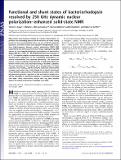| dc.contributor.author | Bajaj, Vikram S. | |
| dc.contributor.author | Mak-Jurkauskas, Melody L. | |
| dc.contributor.author | Belenky, Marina | |
| dc.contributor.author | Herzfeld, Judith | |
| dc.contributor.author | Griffin, Robert Guy | |
| dc.date.accessioned | 2010-03-10T15:50:11Z | |
| dc.date.available | 2010-03-10T15:50:11Z | |
| dc.date.issued | 2009-06 | |
| dc.date.submitted | 2009-01 | |
| dc.identifier.issn | 0027-8424 | |
| dc.identifier.uri | http://hdl.handle.net/1721.1/52459 | |
| dc.description.abstract | Observation and structural studies of reaction intermediates of proteins are challenging because of the mixtures of states usually present at low concentrations. Here, we use a 250 GHz gyrotron (cyclotron resonance maser) and cryogenic temperatures to perform high-frequency dynamic nuclear polarization (DNP) NMR experiments that enhance sensitivity in magic-angle spinning NMR spectra of cryo-trapped photocycle intermediates of bacteriorhodopsin (bR) by a factor of ≈90. Multidimensional spectroscopy of U-13C,15N-labeled samples resolved coexisting states and allowed chemical shift assignments in the retinylidene chromophore for several intermediates not observed previously. The correlation spectra reveal unexpected heterogeneity in dark-adapted bR, distortion in the K state, and, most importantly, 4 discrete L substates. Thermal relaxation of the mixture of L's showed that 3 of these substates revert to bR568 and that only the 1 substate with both the strongest counterion and a fully relaxed 13-cis bond is functional. These definitive observations of functional and shunt states in the bR photocycle provide a preview of the mechanistic insights that will be accessible in membrane proteins via sensitivity-enhanced DNP NMR. These observations would have not been possible absent the signal enhancement available from DNP. | en |
| dc.description.sponsorship | National Institute of Biomedical Imaging and Bioengineering of the National Institutes of Health (Grants EB-001960, EB-002804, EB002026, and EB-001035) | en |
| dc.language.iso | en_US | |
| dc.publisher | National Academy of Sciences | en |
| dc.relation.isversionof | http://dx.doi.org/10.1073/pnas.0900908106 | en |
| dc.rights | Article is made available in accordance with the publisher's policy and may be subject to US copyright law. Please refer to the publisher's site for terms of use. | en |
| dc.source | PNAS | en |
| dc.subject | magic-angle spinning | en |
| dc.subject | photocycle intermediate | en |
| dc.subject | retinal protein | en |
| dc.subject | ion transport | en |
| dc.subject | DNP | en |
| dc.title | Functional and shunt states of bacteriorhodopsin resolved by 250 GHz dynamic nuclear polarization-enhanced solid-state NMR | en |
| dc.type | Article | en |
| dc.identifier.citation | Bajaj, Vikram S. et al. “Functional and shunt states of bacteriorhodopsin resolved by 250 GHz dynamic nuclear polarization–enhanced solid-state NMR.” Proceedings of the National Academy of Sciences 106.23 (2009): 9244-9249. © 2009 the National Academy of Sciences | en |
| dc.contributor.department | Massachusetts Institute of Technology. Department of Chemistry | en_US |
| dc.contributor.department | Francis Bitter Magnet Laboratory (Massachusetts Institute of Technology) | en_US |
| dc.contributor.approver | Griffin, Robert Guy | |
| dc.contributor.mitauthor | Bajaj, Vikram S. | |
| dc.contributor.mitauthor | Mak-Jurkauskas, Melody L. | |
| dc.contributor.mitauthor | Griffin, Robert Guy | |
| dc.relation.journal | Proceedings of the National Academy of Sciences of the United States of America | en |
| dc.eprint.version | Final published version | en |
| dc.identifier.pmid | 19474298 | |
| dc.type.uri | http://purl.org/eprint/type/JournalArticle | en |
| eprint.status | http://purl.org/eprint/status/PeerReviewed | en |
| dspace.orderedauthors | Bajaj, V. S.; Mak-Jurkauskas, M. L.; Belenky, M.; Herzfeld, J.; Griffin, R. G. | en |
| dc.identifier.orcid | https://orcid.org/0000-0003-1589-832X | |
| mit.license | PUBLISHER_POLICY | en |
| mit.metadata.status | Complete | |
